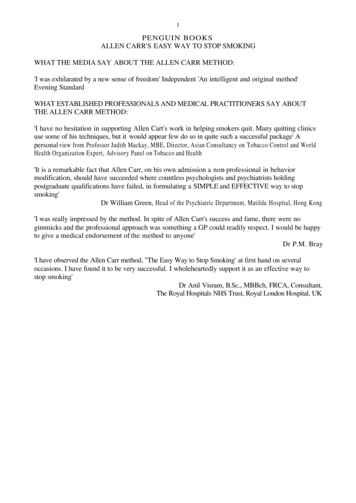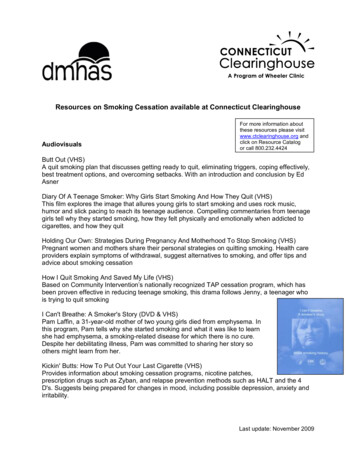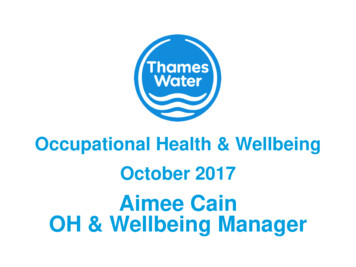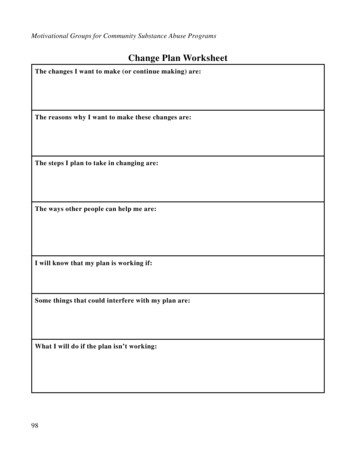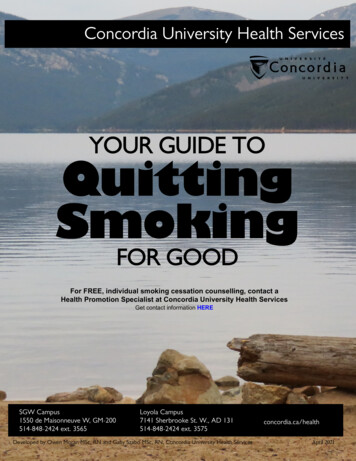
Transcription
Concordia University Health ServicesYOUR GUIDE TOQuittingSmokingFOR GOODFor FREE, individual smoking cessation counselling, contact aHealth Promotion Specialist at Concordia University Health ServicesGet contact information HERESGW Campus1550 de Maisonneuve W, GM-200514-848-2424 ext. 3565Loyola Campus7141 Sherbrooke St. W., AD 131514-848-2424 ext. 3575Developed by Owen Moran MSc, RN and Gaby Szabo MSc, RN, Concordia University Health Servicesconcordia.ca/healthApril 2021
Quitting Tobacco for Goodin a Nutshell1.To quit using tobacco for good you need torecognize that you are addicted to nicotine.When you don’t get it you experience negativeemotions. You don’t like feeling these negativeemotions so you continue to smoke.2.To effectively quit using tobacco for good, youneed to develop an attitude where youdedicate and commit yourself to achieving asmoke-free life. Your mind has to be made up sothat nothing will get in the way of achieving thismost important goal!!! You need to see quittingas a gift you are giving yourself rather than adeprivation.3.To quit using tobacco for good you need todevelop and implement effective,nicotine-free coping strategies that youcan use to manage the temporary, negativeemotions that come when your brain stopsgetting nicotine.
Your Plan to Quitting Smoking For GoodIf you have ever tried quitting smoking before you will attest to the fact that it can be a very difficult thing to do. As such,to quit smoking for good you need a plan. The information and exercises in this book are your plan. As with anythingelse worth having, achieving a tobacco-free life requires effort. Addictions are tough to break. Putting in the effort andenergy is necessary to ensure success. Therefore, the most important feature of successfully breaking free from tobaccouse is this:You need to immerse yourself in the smoking cessation process!!This means that: quitting smoking becomes the number one project in your life. Of course, you continue to fulfill your school andwork responsibilities, but quitting smoking is always on your mind because it is the number one thing you can do toimprove your health and life!!! you read through this entire booklet and do all the exercises. you think about quitting and the role of tobacco in your life any chance you get (e.g. on the bus, walking etc). you visualize your life as a non-smoker and think about how fantastic it will be to be free of tobacco! you read about smoking cessation whenever you can. You make time for it. Some quit smoking resources areprovided below. you talk to people who have effectively quit smoking and ask them how they did it, what challenges they faced andwhat has kept them smoke-free.Also, ask them for any advice they would have that can help you in your process.The information and exercises in this booklet that form your plan are divided into 3 main sections. They are:1. Understand nicotine addiction. Of the over 4,000 chemicals found in tobacco smoke, only one keeps youcoming back: NICOTINE. Once you acknowledge that you are addicted to nicotine and understand how nicotineaddiction happens, you will be in an excellent position to go smoke-free.2. Cultivate an attitude of dedication and commitment to smoke-free living. In essence, you need to see quittingsmoking as a gift you are giving yourself rather than a deprivation. This is an extremely important point. If you don’tadopt this attitude, your chances of successfully quitting will be severely compromised.3. Identify, develop and implement coping strategies to manage the temporary, negative emotions that come fromnicotine withdrawal. There are hundreds of nicotine-free ways to cope with negative emotions. Discover them, buildthem, and use them.Some Smoking Cessation ResourcesThe Quitting Smoking section of the Health Services website has information on smoking cessation as well aslinks to on-line resources as well as books and hot lines. They include:I Quit Now: "Want to quit smoking? Maybe you’re still hesitating. We have what you need to help youbreak free from tobacco on your own." Has telephone and text message support. From Tobacco-FreeQuebec.Break it Off: This campaign from Health Canada and the Canadian Cancer Society "helps young adultsquit smoking and stay smoke-free."On the Road to Quitting: You can download this booklet, from Health Canada.Alan Carr's Easy Way to Stop Smoking is the world's best-selling self-help book to quit smoking. TheEasy Way website offers 10 Best Tips to Help You Stop Smoking.Nova’s “The Dope on Nicotine” visually shows how nicotine affects the brain and leads to addiction.1
2The PlanThere are two main ways to proceed with this plan: cut down or quit “cold turkey” (without cutting down). The choice isyours. However, this booklet encourages you to use the cut down method for two main reasons. Firstly, by cutting downyou will gradually decrease the amount of nicotine that reaches your brain in the course of a day. This lets your brainprogressively adjust to nicotine withdrawal. Secondly, and more important, as you decrease the amount that you smoke,you will have the opportunity to put in place the coping strategies that you are developing. In essence, this gives you achance to try these coping strategies out and to refine them before you are actually smoke-free. You will be able todiscover what works and what doesn’t, and to make changes so that these strategies will work once you are totallysmoke-free!!What follows is your quit smoking plan outlined week by week if you choose the cut down method. Check off the boxnext to the activity once it is complete. This will help you stay on track. If you choose the “cold turkey” method, set a quitdate, complete all the activities in the booklet, and then apply all you have learned on your quit day and beyond.Week 1:Immerse yourself in the quit smoking process. Dedicate yourself to quitting. Read about it. Think about it. Talkqqabout it. Visualize it. Do all the exercises in this booklet. See previous page for more information.Decide on a quit date. We suggest that this date be 3 weeks from the day you begin the plan. It can be any day of the week.Use a calendar to clearly mark your quit date. We have provided a calendar template for you on the back page to plan your quit. Tell peopleabout your quit date. Post your quit date on the fridge, your computer or on the bathroom mirror where you can see it everyday. As for whichdate to choose, you should do it at a time when you are in your regular rhythm of life. Your nicotine addiction creates a “nicotine filter” whichwill find numerous reasons why every choice for a date is a bad choice (“Can’t do it now because it is exam time”, “Can’t do it now because itis the beginning of the semester”, ”Can’t do it now because it’s the holidays”, “Can’t do it now because I just broke up with someone.”) Therewill never be a “perfect” time. The sooner the better.Determine a cut down plan. If you choose to cut down, use the calendar on the back page to determine how many cigarettesyou will smoke each day. For example, if you currently smoke 20 cigarettes a day and you will quit in 3 weeks, you will cut down by one aday from the beginning of the process until quit day. If you currently smoke 7 cigarettes a day you will cut down by one cigarette every 3days. Write down on the calendar how many cigarettes you have available each day. You can smoke less than that amount, but never more.Don’t save up cigarettes to transfer to other days.q Cut down the number of cigarettes you smoke each day according to your calendarq Separate smoking from all your activities. There is a strong association between smoking and some of your activitiessuch as talking on the phone, driving, working on the computer etc. From the minute you begin this program, when you smoke you don’t doanything else.you smoke while still (don’t walk and smoke) and alone (don’t smoke with anyone else or in front of the TV or computer). Youwill likely realize how boring smoking is, and how strong the associations are between your activities and smoking. (You might not even wanta coffee if you can’t have a cigarette with it.) Break those associations now!!! When quit day comes you will not have to struggle with theurge to smoke as you engage in those activities because you will have already broken the connection. Furthermore, you will re-discover thepleasures that tobacco has come to take the credit for. For example, you may discover that it is in fact the coffee you enjoy, not the cigarette.q Read the entire section on nicotine addictionq Do exercise NIC1: Nicotine Addiction and Meq Do exercise Att1: The Benefits of Going Smoke-freeq Do exercise Att2: The Costs of Smoking: Money and Timeq Do exercise Att3: How Using Tobacco Fits with My Valuesq Do exercise Att4: How Using Tobacco Fits with My Goalsq Read Att5: Disputing the Myths About Smokingq Begin exercise Cope1: Monitoring my Tobacco Use (in center page)q Read introduction to section 3: Build Coping Strategiesq Read “A Few Words About Quit Smoking Aids”q Do exercise Cope 2: Overcoming the Barriers to Becoming Smoke-free, Part 1: My Reasons to Quit/My Reasons to Continueq Do exercise Cope 3: My Strengthsq Do exercise Cope 4: What Makes Me Happyq Begin to list your coping strategies in exercise Cope10: My List of Coping Strategies
Week 2:q Continue immersing yourself in the quit smoking process. Continue living your dedication to quitting. Readabout it. Think about it. Talk about it. Visualize it. Do all the exercises in this booklet.q Continue separating smoking from all your activities. (See week 1). When you smoke, that is all you do.Smoke alone and still.q Continue keeping track of all the cigarettes you smoke with exercise Cope1: Monitoring MyTobacco Useq Continue cutting down the number of cigarettes you smoke each day according to yourcalendarq Begin exercise Cope5: Planning for Challenging Timesq Do exercise Cope6: Overcoming the Barriers to Becoming Smoke-free, Part 2q Do exercise Cope7: What to Do With Extra Money and Extra Timeq Do exercise Cope8: Identify Rewardsq Read Cope9: Symptoms of Recovery and How to Manage Themq Continue to list your coping strategies in exercise Cope10: My List of Coping Strategiesq Begin to fill out your wallet card Cope11 (on center page).Week 3:q Continue immersing yourself in the quit smoking process. Continue living your dedication to quitting. Readabout it. Think about it. Talk about it. Visualize it. Do all the exercises in this booklet.q Continue separating smoking from all your activities. (See week 1). When you smoke, that is all you do.Smoke alone and still.q Continue cutting down the number of cigarettes you smoke each day according to yourcalendarq Continue keeping track of all the cigarettes you smoke with exercise Cope1q Continue exercise Cope5: Planning for Challenging Timesq Continue to list your coping strategies in exercise Cope10: My List of Coping Strategiesq Continue filling out your wallet card in exercise Cope11Week 4 and beyondAs you begin week 4, you will be smoke-free. The task from now on is to remain smoke free.q Monitor your progress. Find a way to mark that you are on track. For example, you can get a calendar and place a star or otherqmark for each day you don’t use tobacco. Alternatively, you can put the amount of money you have saved into a jar and watch it accumulatequickly. Be creative in finding a way to monitor.Review the benefits you have achieved. From the minute you quit using tobacco you will begin to experience benefits.Think about how wonderful these are!! Some common early benefits include more energy, more time, more money, clearer and brighter skin,better breath, and you smell nicer. Think about the many more benefits that you will achieve as you remain smoke-free. You may experiencesome symptoms of withdrawal (see Cope9). Remind yourself that these are temporary and that there are many things you can do toovercome them.Celebrate your success. Quitting smoking can be very difficult. Every day you remain smoke-free deserves someacknowledgement of the success. Reward yourself (review your rewards sheet: exercise Cope8).qq If you ever have a slip or relapse, read “In case of a Slip” at the end of the booklet toidentify and put in place strategies to return to smoke-free living.3
4Understand Nicotine AddictionOf the over 4,000 compounds in tobacco, only one is responsible for a person continuing to smoke: NICOTINE!!! If thenicotine in tobacco were to be removed, a smoker (nicotine addict) would lose the desire to smoke, just as a person whois living with alcoholism would lose the desire to drink beer if the alcohol were removed. The only reason you continueto smoke is because you are addicted to nicotine. So, how does this substance make a person come back to tobaccoover and over again, despite a long list of potential consequences of continued use? Read on to find out.Understand Nicotine AddictionHow Does Nicotine Addiction HappenWhat follows is a scientific summary of nicotine addiction. If science is not your thing, skip to the bottom to read theinformation in the “Nicotine Addiction in Plain English” box.Tobacco leaves contain nicotine, and when they burn, the nicotine is releasedNicotine occurs naturally in tobacco leaves. When a person lights a cigarette, the tobacco leaves and other added compoundsreach 900 C and gases and particles are released. The particles are seen as smoke, and the sum total of these particles iscalled tar. Over 4,000 compounds have been identified in the tar and gases released from burning tobacco. About 40 of thesecompounds are known to cause cancer. Nicotine itself does not cause cancer and is relatively harmless to health in theamounts found in cigarettes. However, it is the only compound that keeps a person coming back to tobacco.NicotinemoleculeInhaled cigarette smoke contains nicotine that quickly reaches the brain via the lungsWhen a person inhales, nicotine from the burning tobacco enters the lungs, is absorbed into the bloodstream, and istransported to the brain. The nicotine leaves the bloodstream and “bathes” the cells of the brain.Brain cells communicate with each other through neurotransmitters and receptorsAt this point, a brief review of how nerve cells communicate is needed to fully understand nicotine addiction. Nerve cells, suchas those in the brain, do not actually touch each other. They are separated by a small space called a synapse. In order for amessage (an electrical current) to be transmitted from nerve cell A to nerve cell B, neurotransmitters from cell A are releasedinto the synapse and they bind to specific receptors on cell B. When enough receptors are filled, an electrical current begins incell B that continues to the end of that cell where it meets cell C, and more neurotransmsitters are released from cell B whichbind to the receptors on cell C and the message continues.cell Acell BNicotine “sneaking”into receptorsynapseNicotine overpowers receptors in an area of the brain that is responsible for feelings of pleasure and rewardThe nicotine molecule has a shape that fits perfectly into the receptors on nerve cells in the pleasure/reward center of the brain.These receptors are not meant to accept nicotine. When a person uses tobacco, a large number of nicotine molecules reachthe brain, bind to these receptors and spark a message in the pleasure/reward center of the brain, where there wasn’t onebefore. This stimulation of the pleasure center is felt by the tobacco user as pleasurable.The body breaks down nicotine; levels in the blood and brain drop; and the brain becomes“unhappy”The body recognizes nicotine as a foreign substance. The liver breaks down nicotine that is circulating in the blood intocompounds that are eliminated in the urine. The moment a person puts out a cigarette, the level of nicotine in the blood (andthe brain) begins to decrease. This results in a decrease in the stimulation of the pleasure/reward center of the brain and theperson begins to experience negative emotions such as irritability, anxiety, and sadness. Of course, the smoker doesn’t enjoythis negative state of mind, so as it builds s/he reaches for a cigarette, takes a few puffs and the pleasure center is stimulatedagain. These negative emotions are relieved for a short period, until nicotine levels drop again after the cigarette is put out. It isimportant to note that once this vicious cycle has begun, the smoker does not smoke to create pleasure; rather, s/he smokes torelieve negative emotions. Smoking does not create a “high”; it temporarily removes a low!!!Nicotine Addiction in Plain EnglishNicotine in tobacco smoke gets into your lungs and then your brain, where it stimulates thepleasure/reward center. After you have finished a cigarette, the amount of nicotine in the braindrops and you begin to experience negative emotions. When you get another “hit” of nicotine byhaving another cigarette, bad feelings disappear (momentarily) as the pleasure/reward center isstimulated again. But nicotine levels drop once more, negative emotions return and the cycle ofsmoking continues to relieve these emotions.
5Understand Nicotine AddictionHow Addictive is Nicotine?Dr. Jack E. Henningfield of the National Institute on Drug Abuse and Dr. Neal L. Benowitz of the University of Californiaat San Francisco are respected experts in the field of addiction. They independently ranked six substances based onfive problem areas (listed below). They were asked to rank the substances on a scale of 1 to 6, where 1 is the mostserious and 6 is the least serious. As you can see from the tables below, they ranked nicotine as the most difficult to quit(dependence). Nicotine was rated more difficult to quit than heroin or cocaine.The point of showing this is to demonstrate that quitting smoking can be difficult. However, millions of people quitevery year. Quitting smoking can be much easier if you have a plan and the right attitude.Withdrawal: Presence and severity of characteristic withdrawal symptoms.Reinforcement: A measure of the substance's ability, in human and animal tests, to get users to take it again and again, and in preference toother substances.Tolerance: How much of the substance is needed to satisfy increasing cravings for it, and the level of stable need that is eventually reached.Dependence: How difficult it is for the user to quit, the relapse rate, the percentage of people who eventually become dependent, the rating usersgive their own need for the substance and the degree to which the substance will be used in the face of evidence that it causes harm.Intoxication: Though not usually counted as a measure of addiction in itself, the level of intoxication is associated with addiction and increases thepersonal and socIal damage a substance may do.Henningfield neMarijuanaBenowitz orcement421365Reinforcement421356Adapted from Philip J. Hilts in the New York Times, August 2 1994.Tolerance214356Tolerance421356Dependence Intoxication153324562164Dependence Intoxication163324562154Also, from the experience of the Haight Ashbury Drug Clinic in San Francisco, professionals listed drugs in the order ofspeed with which a person progresses from experimentation and social use to habituation, abuse and addiction. Theirlist is as follows, with the substance at the top of the list representing the most “addictive”:1. Nicotine2. “Crack” cocaine (smoking or IV)3. Heroin (smoking or IV)4. Methamphetamine (IV)5. Cocaine (snorting)6. Amphetamine (oral)7. Sedative-hypnotics8. Marijuana9. Caffeine10. PCP11. Ecstasy (MDMA)12. LSD13. Mescaline/peyoteSource: A Matter Of Balance by Michael E. Holstein et al (1995)
6Understand Nicotine AddictionNIC 1: Nicotine Addiction and MeOne of the features of nicotine addiction is that the brain sets up a “nicotine filter” where any information that supportscontinuing to smoke gets attention (“My grandmother smoked her whole life and died in her sleep at a ripe old age”, “You couldget hit by a bus tomorrow”, “Smoking helps me manage stress” etc.) and any information that supports quitting is ignored (“Halfthe people who smoke regularly will die of smoking-related causes”, “Tobacco use is the number one preventable cause ofdeath in Canada” etc.). If your “nicotine filter” is up you might be thinking “I am not addicted to nicotine”, “It’s just a bad habit”or “I can quit anytime I want to”. Take the quiz below to see if you exhibit some of the signs of nicotine addiction. A “yes”answer indicates addictive behaviour.Yes NoYes NoMy smoking has a pattern (e.g. I smoke as soon as II have smoked in places where it is forbidden to smoke.finish a meal, or I smoke on a work break) and if for anyIf I am in a bar/restaurant with others, I will leave them to goreason I can’t smoke at those usual times I getoutside to smoke.nervous/irritable/anxious.I feel nervous or anxious if I run out of cigarettes.I get up in the morning and have a cigarette right away.I make sure to always have enough cigarettes so that II have done without certain things so that I would havewon’t run out.enough money to buy cigarettes.I have tried to quit smoking in the past without success.I have smoked even though I was sick and couldn’t goIf I don’t smoke for a while, I get irritated, nervous orto school or work.anxious.I have smoked cigarette butts (either mine or anotherI have lied to people about my smoking.person’s).I hide my smoking from people.I have done something uncomfortable in order toI have avoided going to places where I knew I wouldn’t besmoke, such as go outside in very cold weather.able to smoke.I have smoked 2 (or even 3 cigarettes) in a row beforeI get irritated by people who talk to me about my smoking orgoing somewhere where I knew I wouldn’t be able towho encourage me to quit.smoke (or right after not being able to smoke for someI have asked a complete stranger for a cigarette.time).The Take Home MessageNicotine stimulates the “pleasure/reward” center of thebrain. When the brain of a smoker is deprived of nicotine,s/he experiences negative emotions. It is these recurringnegative emotions that make a person desire to light upagain, and again, and again, to get rid of the bad feelings.The Good NewsThe urge to smoke will go away whether you smoke or youdon’t!!! As the brain continues to be deprived of nicotine, itwill stop “asking” for this drug. The negative emotionsthat occur when you quit smoking will go away. Thiscycle can be broken, but you need to develop and use othereffective strategies to deal with negative emotions as wellas adopt an attitude where nothing will stop you fromputting those strategies in place.
Build the Right AttitudeNicotine is a highly addictive substance. As such, in order to effectively quit using tobacco you need to approach it witha plan and immerse yourself in the smoking cessation process. An extremely important part of that plan is tocultivate an attitude of dedication and commitment to smoke-free living. Many people believe that motivation andwillpower are what are needed to become a non-smoker. However, this is misleading. Both motivation and willpowercan come and go: they will be with you when things are going well, and they will usually disappear when times aretough. What will help you be successful at quitting forever is to cultivate an attitude that will take you through the toughtimes. This is where dedication and commitment come in. When you are dedicated and committed to a goal there isnothing that can stand in your way of reaching it. The exercises in this section of the workbook all have the objective ofhelping you develop dedication and commitment to smoke-free living. You need to see quitting smoking as a gift youare giving yourself and not a deprivation. Again, it is important to repeat that unless you have made up your mindthat quitting is the most important thing that you can do for your health and your life, your efforts to go smoke-free willlikely be short lived, if going smoke-free happens at all.Build the Right AttitudeATT 1: The Benefits of Going Smoke-freeToo often, those trying to help people to quit smoking stress the bad things that will happen if they continue to smoke.Many smokers ignore this information, saying that they know it all. We believe that focusing on the positives of quittingcan help you build that dedication and commitment to smoke-free living. Just look at the wonderful things that arewaiting for you in your smoke-free life. On the next page review the benefits of going smoke-free. Check off any of thebenefits that you would like to experience. Don’t be limited to the ones we have included. Go even further and addsome of your own personal benefits at the end.Build the Right AttitudeATT 2: The Cost of Smoking: Money and TimeMost tobacco users are unaware of the amount of money they spend on tobacco each year as well as the amount oftime they spend smoking each year. Take a few minutes to calculate how much of these two resources you commit toyour tobacco use. If you buy tobacco and roll your own or buy cigarettes illegally in bulk (e.g. ziplock bags) then theformula below will not work. You can still calculate how much you spend by figuring out how frequently you buy tobaccoand for what price.How Much Money I Spend onTobacco Each YearA. Determine how many cigarettes you smoke each day on average:cigarettes per dayB. Multiply A by 365 to identify how many cigarettes you smoke eachyear: cigarettes each yearC. Divide B by the number of cigarettes in the packs that you buy(either 20 or 25 cigarettes per pack) packs per yearD. If you buy cigarettes by the pack, Multiply C by the price of apack of cigarettes (price of packs of cigarettes I buy ) spent on cigarettes each yearIf you buy cigarettes by the carton, divide C by the number of packs in a carton(usually 8 or 10) to determine the number of cartons of cigarettes you smoke eachyear: cartons. Then multiply the number of cartons per year by the price ofa carton spent on cigarettes each yearHow Much Time I Spend SmokingEach YearA. Determine how many cigarettes you smoke each day, onaverage: cigarettes per dayB. Multiply A by the number of minutes it takes you to smoke acigarette (usually between 5 and 10 minutes)minutes it takes me to smoke a cigarette x (A) minutes spent smoking each dayC. Multiply B by 365 to identify the number of minutes you spendsmoking each yearminutes spent smoking each yearD. Divide C by 60 to determine the number of hours you spendsmoking each yearhours spent smoking each yearE. Divide D by 24 to determine the number of days you spendsmoking each yeardays spent smoking each year7
The Benefits of Going Smoke-free8Listed below are some of the many benefits of going smoke-free. Review this list and check offany of the benefits that you would like to achieve. Add your own benefits at the end.Proven Health BenefitsBy quitting smoking a person will REDUCE his/her risk of:Cardiovascular diseases including:Abdominal aortic aneurysm (weak spots in heartvessels)Atherosclerosis (hardening of the arteries)Stroke (which can lead to death or paralysis)Heart attackPeripheral vascular disease (circulatory problems)High blood pressureCancer of the:BladderEsophagusKidneyTbene heLarynxBlood (leukemia)just tofits areoLungto pasgreatMouthPancreasup!!! sStomachRespiratory diseases including:PneumoniaChronic bronchitisEmphysema/COPDInfluenza (the "flu")The common coldqqqqqqqqqqqqqqqqqqqqOther health benefits include REDUCED risk of:High cholesterol (LDL)HeadachesMigrainesStomach ulcersChronic bowel disease (Crohn's Disease)Tooth decay (cavities)Gum diseaseOsteoporosisSleep problems (trouble falling asleep and/or frequentwaking)CataractsAge-related macular degeneration (eye disease thatleads to blindness)Thyroid disease (Grave's Disease)Hip fracturesLow bone densityqqqqqqqqqqqqqqFemale smokers will REDUCE their risk of:Other Benefits Include:q More time for yourselfq More moneyq More energy/vitalityq Increased life expectancyq Better quality of lifeq Increased sense of control/more freedomq Feel more socially acceptableq Reduced embarrassmentq House, hair and clothes will smell betterq Decreased risk of diseases of household membersfrom second-hand smokeq Decreased guilt of harming familyq Be more considerate to non-smokers, children andanimalsq Build more, and effective, coping skillsq Become a good role modelq Increased sense of self-esteemq Feel proud of yourselfq Others feel proud of youq Increased confidence in setting and achievinggoalsq Decreased dry mouthq Decreased sore throatq Decreased coughingq Decreased yellow teeth/fingers/hairq Skin won't age as quickly/better skinq Increased sense of tasteq Increased sense of smellq Better and more sexq Be calmer/more focusedq Get a new identityq Don't support tobacco companies anymoreq Decreased negative impact on the environment*q Freedom from nicotine urges and cravingsq Decrease nagging feeling of always wanting to quitq Decrease chance of a house fire**Other benefits I may experiencefrom quitting that are not listedhere:qqqqqqqq Cancer of the cervix (womb)q Menstrual problemsq Fertility problemsq Spontaneous abortion (miscarriage)q A low birth weight babyq Pregnancy complications* Millions of acres of forests have been cleared to plant tobacco. Millions of treeshave been cut down to provide wood to cure tobacco. Pesticides, fungicides andfertilizers are used to grow tobacco. Forty percent of the garbage in the streets andon the world’s shorelines is tobacco related. Birds and fish die from accidentallyeating tobacco butts.and the list goes on.q Erectile dysfunction (impotence)q Fertility problems (problems with sperm)** Cigarettes are the number one known cause of fire-relat
Alan Carr's Easy Way to Stop Smoking is the world's best-selling self-help book to quit smoking. The Easy Way website offers 10 Best Tips to Help You Stop Smoking. Nova’s “The Dope on Nicotine” visuallyshow
